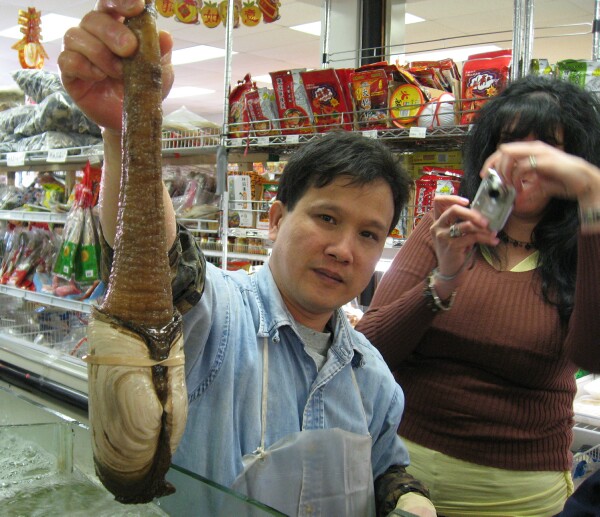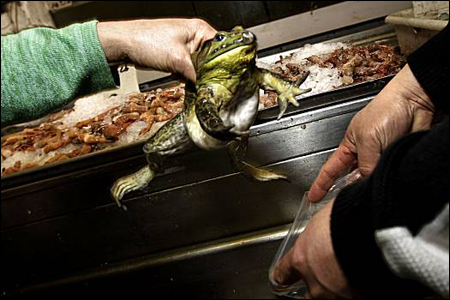It’s one of those restaurant things I have fun with.
Any seafood place will proudly declare their fish is wild, not the farmed stuff.
For 15 years, I’ve asked servers, do you have farmed salmon or whatever aquatic delight awaits my tummy.
 The server will brag and brag about how all the seafood they serve is wild, and not the nasty farmed stuff.
The server will brag and brag about how all the seafood they serve is wild, and not the nasty farmed stuff.
Wrong answer.
Like raw-egg aioli.
Elizabeth Weise of USA Today writes that farmed fish has gotten a bad rap, but it’s the only way the world is going to feed the additional 2.4 billion people expected to be added to the Earth’s population in the next 34 years, experts told a sustainable food conference.
With the world’s arable land maxed out and wild seafood overfished, aquaculture is the one place we can look to produce enough animal protein for all those extra mouths, said Steve Gaines (left, not exactly as shown), a professor of marine biology at the University of California Santa Barbara and lead investigator for the university’s sustainable fisheries group. He spoke at a conference on sustainable food at the Monterey Bay Aquarium earlier this month.
The rising human population isn’t the only issue. As standards of living rise, people eat more protein and especially more meat. In China, for example, annual meat consumption has risen from 28 pounds per person in 1982 to 138 pounds in 2015.
Growing enough crops to feed more pigs, chickens and cows is a challenge. In most of the world, all the land that can be planted already is planted. Plowing under the marginal land that’s left would only lead to deforestation and land degradation, which only contributes to climate change, said Gaines.
Turning to the world’s oceans doesn’t help. Analysis of global fisheries, even if all were sustainably managed for maximum production, would only take care of between 1% and 5% of the coming demand, Gaines said.
The only option, experts at the Monterey conference said, is aquaculture. Currently just 15% of world animal protein consumption comes from aquaculture but that can quickly be ramped up.
 It’s a hard sell in the United States. Panelists blamed part of the U.S. prejudice against aquaculture on NIMBYism (i.e. Not In My Backyard.) Americans were content to eat farmed salmon, shrimp, oysters and other species when they were produced far away, but didn’t want to see fish farms and pens in their pristine waters at home.
It’s a hard sell in the United States. Panelists blamed part of the U.S. prejudice against aquaculture on NIMBYism (i.e. Not In My Backyard.) Americans were content to eat farmed salmon, shrimp, oysters and other species when they were produced far away, but didn’t want to see fish farms and pens in their pristine waters at home.
There’s also an ongoing negative connotation with fish farming among the more eco-conscious in the United States because of early unsustainable fishery examples, especially farmed salmon and shrimp, in South America and Asia.
Asian seafood producers have been cleaning up their acts but damaging stories about aquaculture there continue to make the rounds, said Kevin Fitzsimmons, a professor of aquaculture at the University of Arizona in Tucson, Az.
He says he frequently hears Americans complain about agricultural leavings and animal waste being used in fish ponds in southeast Asia, a practice that’s actually both sustainable and deeply rooted in the culture, he said.
“In the United States, if somebody puts chicken waste in their garden they’re an organic farmer and it’s wonderful. But if they put it in a fish pond in China, we say they’re trying to kill us,” he said.
Today a wave of innovation and investment has meant that aquaculture overall is much more environmentally friendly and efficient than it once was.
Currently 78% of the salmon Americans eat is farmed, according to research by Oai Li Chen at the University of Washington. However, as a whole, salmon makes up just one-fifth of world aquaculture production, said Peet.


 year by state agents who leveled criminal charges against two managers of the store accusing them of illegally selling wildlife.
year by state agents who leveled criminal charges against two managers of the store accusing them of illegally selling wildlife. lacked permits, according to prosecutors’ court filings.
lacked permits, according to prosecutors’ court filings. My full answer included,
My full answer included, McDonald’s reconsidered its old assumptions about food — from how often beef-processing plants should test ground beef to how well a hamburger must be cooked to kill off pathogens such as E. coli and salmonella.
McDonald’s reconsidered its old assumptions about food — from how often beef-processing plants should test ground beef to how well a hamburger must be cooked to kill off pathogens such as E. coli and salmonella..jpg) If more inspectors are the answer to safer food, why would the inspectors need publicly reported accounts of foodborne illness and death to try harder?
If more inspectors are the answer to safer food, why would the inspectors need publicly reported accounts of foodborne illness and death to try harder?.jpeg) Then on Oct. 22, the inspector saw a worker using a forklift to move ready-to-eat link sausages from the cooler to a line for packaging. The report notes the meat at the bottom part of the lift "was not protected for the potential wheel over spray or splash cross contamination."
Then on Oct. 22, the inspector saw a worker using a forklift to move ready-to-eat link sausages from the cooler to a line for packaging. The report notes the meat at the bottom part of the lift "was not protected for the potential wheel over spray or splash cross contamination." The best food producers, processors, retailers and restaurants will go above and beyond minimal government and auditor standards and
The best food producers, processors, retailers and restaurants will go above and beyond minimal government and auditor standards and  Whether it’s a recall, an inspection report or a warning label, not everyone who eats in the U.S. is fluent in English. That’s why our
Whether it’s a recall, an inspection report or a warning label, not everyone who eats in the U.S. is fluent in English. That’s why our 


 Marinate farmed salmon fillets (I prefer aquaculture because it is more sustainable) in lime juice, garlic, olive oil and fresh rosemary.
Marinate farmed salmon fillets (I prefer aquaculture because it is more sustainable) in lime juice, garlic, olive oil and fresh rosemary. Don Sapatkin of the Philadelphia Inquirer writes this morning
Don Sapatkin of the Philadelphia Inquirer writes this morning.bmp) It’s not clear that food is any safer when there is greater transparency or even more frequent inspections, "but it does get people to think about food safety," said Doug Powell, an associate professor of food safety at Kansas State University who operates
It’s not clear that food is any safer when there is greater transparency or even more frequent inspections, "but it does get people to think about food safety," said Doug Powell, an associate professor of food safety at Kansas State University who operates 